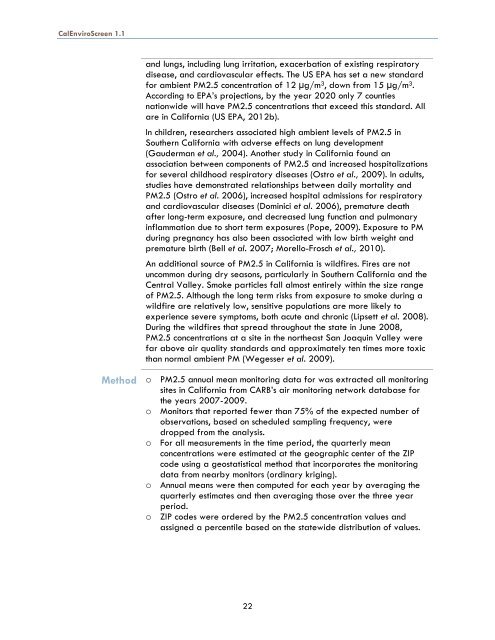CalEnviroscreen Version 1.1 - OEHHA - State of California
CalEnviroscreen Version 1.1 - OEHHA - State of California
CalEnviroscreen Version 1.1 - OEHHA - State of California
Create successful ePaper yourself
Turn your PDF publications into a flip-book with our unique Google optimized e-Paper software.
CalEnviroScreen <strong>1.1</strong><br />
and lungs, including lung irritation, exacerbation <strong>of</strong> existing respiratory<br />
disease, and cardiovascular effects. The US EPA has set a new standard<br />
for ambient PM2.5 concentration <strong>of</strong> 12 µg/m 3 , down from 15 µg/m 3 .<br />
According to EPA’s projections, by the year 2020 only 7 counties<br />
nationwide will have PM2.5 concentrations that exceed this standard. All<br />
are in <strong>California</strong> (US EPA, 2012b).<br />
In children, researchers associated high ambient levels <strong>of</strong> PM2.5 in<br />
Southern <strong>California</strong> with adverse effects on lung development<br />
(Gauderman et al., 2004). Another study in <strong>California</strong> found an<br />
association between components <strong>of</strong> PM2.5 and increased hospitalizations<br />
for several childhood respiratory diseases (Ostro et al., 2009). In adults,<br />
studies have demonstrated relationships between daily mortality and<br />
PM2.5 (Ostro et al. 2006), increased hospital admissions for respiratory<br />
and cardiovascular diseases (Dominici et al. 2006), premature death<br />
after long-term exposure, and decreased lung function and pulmonary<br />
inflammation due to short term exposures (Pope, 2009). Exposure to PM<br />
during pregnancy has also been associated with low birth weight and<br />
premature birth (Bell et al. 2007; Morello-Frosch et al., 2010).<br />
An additional source <strong>of</strong> PM2.5 in <strong>California</strong> is wildfires. Fires are not<br />
uncommon during dry seasons, particularly in Southern <strong>California</strong> and the<br />
Central Valley. Smoke particles fall almost entirely within the size range<br />
<strong>of</strong> PM2.5. Although the long term risks from exposure to smoke during a<br />
wildfire are relatively low, sensitive populations are more likely to<br />
experience severe symptoms, both acute and chronic (Lipsett et al. 2008).<br />
During the wildfires that spread throughout the state in June 2008,<br />
PM2.5 concentrations at a site in the northeast San Joaquin Valley were<br />
far above air quality standards and approximately ten times more toxic<br />
than normal ambient PM (Wegesser et al. 2009).<br />
Method o PM2.5 annual mean monitoring data for was extracted all monitoring<br />
sites in <strong>California</strong> from CARB’s air monitoring network database for<br />
the years 2007-2009.<br />
o Monitors that reported fewer than 75% <strong>of</strong> the expected number <strong>of</strong><br />
observations, based on scheduled sampling frequency, were<br />
dropped from the analysis.<br />
o For all measurements in the time period, the quarterly mean<br />
concentrations were estimated at the geographic center <strong>of</strong> the ZIP<br />
code using a geostatistical method that incorporates the monitoring<br />
data from nearby monitors (ordinary kriging).<br />
o Annual means were then computed for each year by averaging the<br />
quarterly estimates and then averaging those over the three year<br />
period.<br />
o ZIP codes were ordered by the PM2.5 concentration values and<br />
assigned a percentile based on the statewide distribution <strong>of</strong> values.<br />
22















